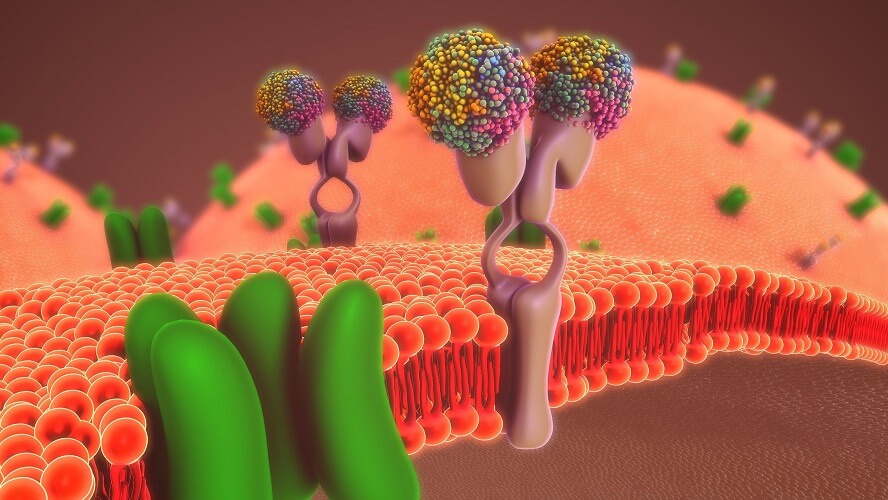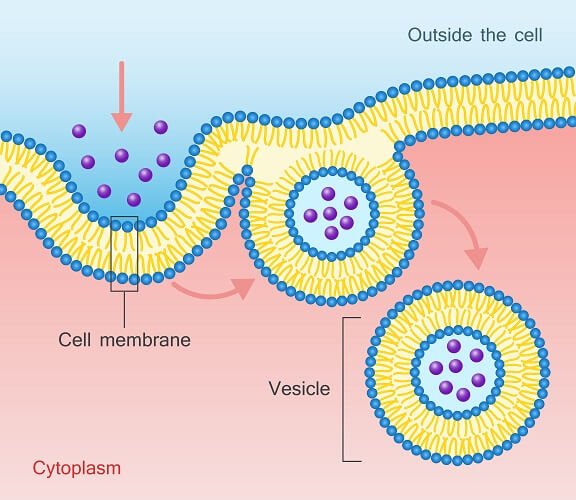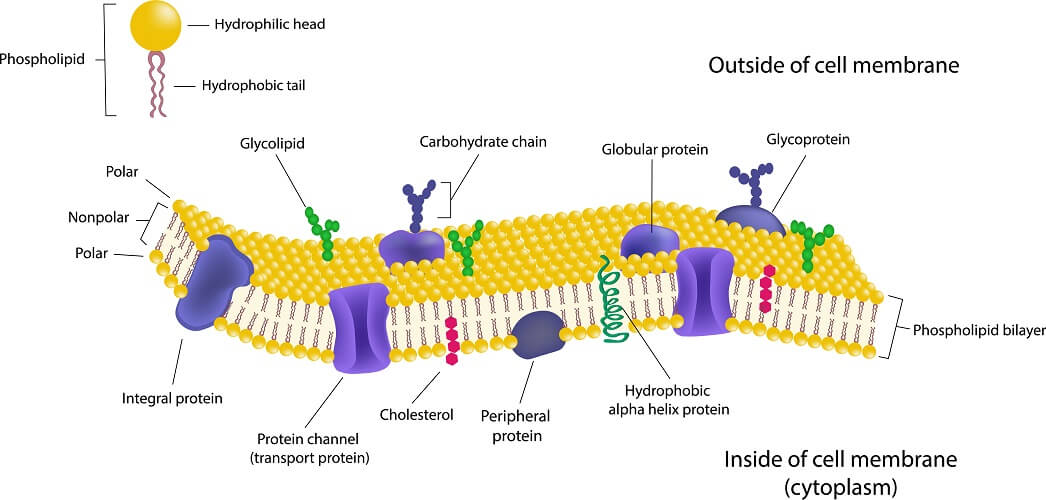Definition
The cell membrane, also known as the plasma membrane, is a double layer of lipids and proteins that surrounds a cell. It separates the cytoplasm (the contents of the cell) from the external environment. It is a feature of all cells, both prokaryotic and eukaryotic.

Function of the Cell Membrane
The cell membrane gives the cell its structure and regulates the materials that enter and leave the cell. It is a selectively permeable barrier, meaning it allows some substances to cross, but not others. Like a drawbridge intended to protect a castle and keep out enemies, the cell membrane only allows certain molecules to enter or exit.
Crossing the Membrane
Small molecules, such as oxygen, which cells need in order to carry out metabolic functions such as cellular respiration, and carbon dioxide, a byproduct of these functions, can easily enter and exit through the membrane. Water can also freely cross the membrane, although it does so at a slower rate.
However, highly charged molecules, like ions, cannot directly pass through, nor can large macromolecules like carbohydrates or amino acids. Instead, these molecules must pass through proteins that are embedded in the membrane. In this way, the cell can control the rate of diffusion of these substances.
Another way the cell membrane can bring molecules into the cytoplasm is through endocytosis. The reverse process, where the cell delivers contents outside the membrane barrier, is called exocytosis.
Endocytosis includes phagocytosis (“cell eating”) and pinocytosis (“cell drinking”). During these processes, the cell membrane forms a depression, surrounding the particle that it is engulfing. It then “pinches off” to form a small sphere of membrane called a vesicle that contains the molecule and transports it to wherever it will be used in the cell.

Cells can also deliver substances across the cell membrane to the external environment through exocytosis, which is the opposite of endocytosis. During exocytosis, vesicles form in the cytoplasm and move to the surface of the cell membrane. Here, they merge with the membrane and release their contents to the outside of the cell. Exocytosis removes the cell’s waste products, which are the parts of molecules that are not used by the cell, including old organelles.
Signaling at the Cell Membrane
The cell membrane also plays an important role in cell signaling and communication. The membrane contains several embedded proteins that can bind molecules found outside of the cell and pass on messages to the inside of the cell.
Importantly, these receptor proteins on the cell membrane can bind to substances produced by other areas of the body, such as hormones. When a molecule binds to its target receptor on the membrane, it initiates a signal transduction pathway inside the cell that transmits the signal to the appropriate molecules.
As a result of these often complex signaling pathways, the cell can perform the action specified by the signaling molecule, such as making or stopping the production of a certain protein.
How does the structure of the cell membrane allow it to carry out these functions?
Structure of the Cell Membrane
Phospholipid Bilayer
The cell membrane is made up of a phospholipid bilayer. Phospholipids are lipid molecules made up of a phosphate group head and two fatty acid tails. Importantly, the properties of phospholipid molecules allow them to spontaneously form a double-layered membrane.
The phosphate group head of a phospholipid is hydrophilic, whereas the phospholipid tail is hydrophobic. This means that the phosphate group is attracted to water, whereas the tail is repelled by water.
When in water or an aqueous solution (including inside the body) the hydrophobic heads of phospholipids will orient themselves to be on the inside, as far away from the water as possible. In contrast, the hydrophilic heads will be on the outside, making contact with the water. The result is that a double layer of phospholipids is formed, with the hydrophobic heads clustering together in the center, and the hydrophilic tails forming the outside of the structure. The technical term for this double layer of phospholipids that forms the cell membrane is a phospholipid bilayer.

Membrane-Associated Factors
In addition to the phospholipid bilayer, the cell membrane also contains lipid molecules, particularly glycolipids and sterols. One important sterol is cholesterol, which regulates the fluidity of the cell membrane in animal cells. When there is less cholesterol, membranes become more fluid, but also more permeable to molecules. The amount of cholesterol in the membrane helps maintain its permeability so that the right amount of molecules can enter the cell at a time.
The cell membrane also contains many different proteins. Proteins make up about half of the cell membrane. Many of these proteins are transmembrane proteins, which are embedded in the membrane but stick out on both sides (i.e., they span across the entire lipid bilayer).
Some of these proteins are receptors, which bind to signal molecules. Others are ion channels, which are the only means of allowing ions into or out of the cell. Scientists use the fluid mosaic model to describe the structure of the cell membrane. The cell membrane has a fluid consistency due to being made up in large part of phospholipids, and because of this, proteins move freely across its surface. The multitude of different proteins and lipids in the cell membrane give it the look of a mosaic.
Quiz
